Welcome, Exiles! In this Path of Exile 2 gearing guide, we’ll break down how the gear system works to give you a solid foundation. We’ll start with the basics, such as your character’s inventory layout, the types of items you can equip, and the different rarity levels. However, the main focus of this guide is on acquiring gear. We’ll cover all the known sources of equipment and share the most efficient methods for farming rare and powerful items that will give your character a significant boost as you progress.
Gearing in PoE 2 can be a painful process, especially if you don't know what you're doing. You can help yourself out by buying guaranteed PoE 2 Unique Items at Skycoach. Get any unique item in the game and make your build standout with this service!
Read our other PoE 2 guides:
- Beginner's Guide
- Leveling Guide
- Best Classes Tier List
- Bosses Guide
- Monk Guide
- Best Builds
- Trading Guide
- Divine Orb Farming Guide
Note: At Skycoach, you can Buy Path of Exile 2 Boost at the best prices with fast delivery. Use our special PROMO CODE (in green) hidden in this article for a 20% DISCOUNT.
Character Inventory Overview
All equipable gear for your character goes into your inventory, taking a dedicated inventory slot. Over the course of development, PoE 2 has changed the structure of the character’s inventory, moving further away from Path of Exile 1 and redefining what items can be equipped and which aren’t. So, let’s take a look at the most up-to-date version of the inventory and break down the Path of Exile 2 gearing system basics.
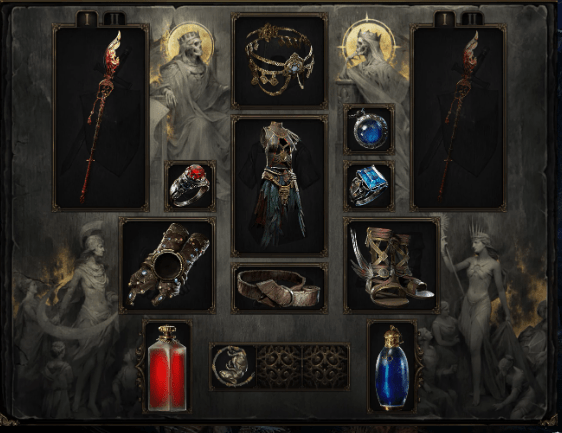
On the screenshot above, you can see the following inventory slots:
- Left-hand (main) weapon slot
- Right-hand (off-hand) weapon slot
- Headpiece slot
- Chest piece slot
- x2 ring slots
- Amulet slot
- Handpiece slot
- Belt slot
- Feet slot
- x2 flask slots
- x3 charm slots
If you’ve played the previous game, you can already notice that some things have changed. While most PoE 2 gear mechanics are the same, a few fundamentals have been completely redesigned. One of the latest editions is the reduction of the amount of flasks a character can have. Now, the amount is limited to only two – one for restoring health and the other for restoring mana. But that’s hardly all the equipment items in the game. There are many more. Have a look at this table for the most complete list of all item types in the game. BLOG20
| Category | Items |
| Weapons | Axes, Bows, Claws, Crossbows, Daggers, Flails, Maces, Quarterstaves, Sceptres, Spears, Staves, Swords, Traps, Wands |
| Off-hands | Foci, Quivers, Shields |
| Armour | Body armors, Boots, Gloves, Helmets, Shields |
| Jewellery | Amulets, Belts, Rings |
| Trinkets | Life flasks, Mana flasks, Charms |
| Socketable items | Skill gems, Support gems, Runes, Soul cores, Jewels |
| Other | Quest items, Unique items, Currency, Waystones, Tablets, Misc. map items |
Besides the new weapon types added in the sequel, there are some items that could use a bit of clarification, so let’s break them down.
Charms
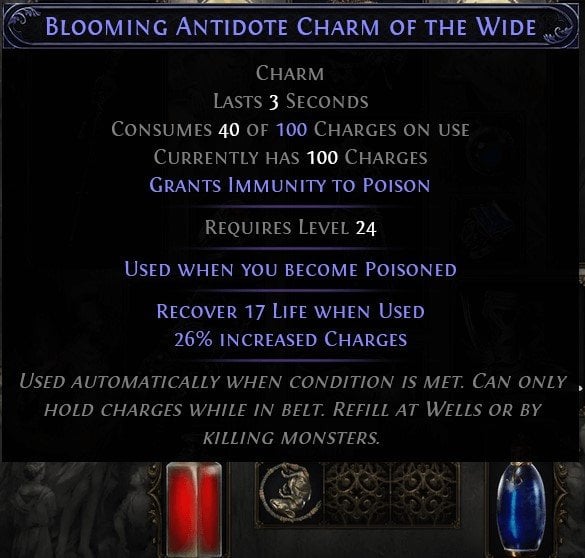
Another interesting addition is the Charms. This is a new type of equipment that provides automatic, temporary buffs or immunities when specific conditions are met. They are designed to enhance survivability and offer strategic advantages during combat. If your build lacks something specific, such as elemental damage resistance, Runes will solve this problem.
Key Features of Charms:
- Automatic Activation: Charms activate automatically when their specific conditions are met, such as taking a certain type of damage or being affected by a particular ailment. For example, a Ruby Charm grants increased fire resistance when you take fire damage from a hit.
- Limited Duration and Charges: Each charm provides its benefit for a set duration and consumes charges upon activation. Charges can be replenished by killing monsters or using Wells in towns.
- Belt Slot Allocation: Charms are equipped in dedicated belt slots, with characters able to equip up to three charms simultaneously. They can only hold charges while equipped in the belt.
- Rarity and Modifiers: Charms can appear in magic rarity, allowing them to have up to two modifiers that enhance their effects. Unique charms with special properties may also be found, offering powerful benefits.
For example, Blooming Antidote Charm of the Wide – Used when you become Poisoned, recovers 17 life when used and gives you 26% increased Charges.
Runes
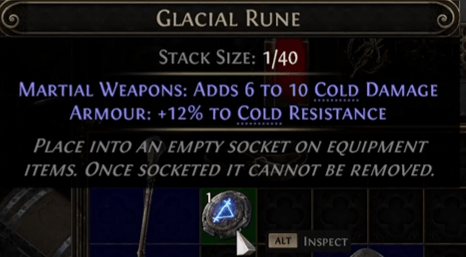
Runes are a bridge between the old way of using gems in the item sockets and the new system in PoE 2. But if you’re not sure what that means, here’s a simpler explanation. In Path of Exile 2, the introduction of Ezomyte Runes adds a new layer to character customization and item enhancement. Here's an overview of their functionality:
Ezomyte Runes:
- Purpose: These runes can be socketed into martial weapons and armor to grant specific modifiers—offensive boosts for weapons and defensive enhancements for armor.
- Socketing Mechanics: Once an Ezomyte Rune is placed into an item's socket, it cannot be removed, making the choice of rune placement significant.
- Socket Availability: Chest pieces and two-handed weapons can have up to two sockets, while other items typically have one. In the endgame, Vaal Orbs can be used to add additional sockets and powerful Soul Cores can be inserted for enhanced bonuses.
Players can obtain Ezomyte Runes through various in-game activities, including defeating enemies, completing quests, and engaging with specific league mechanics. Additionally, runes can be upgraded by vendoring five of the same type to receive one of the next tier.
Item Rarity System Explained

Items in Path of Exile 2 can be broken down into four rarity groups:
- Normal (grey)
- Magic (blue)
- Rare (yellow)
- Unique (orange)
The differences in the Path of Exile 2 item rarity are pretty self-explanatory. The higher the rarity, the more benefits and bonuses the item will have.
- Magic items have up to 2 bonus attributes
- Rare items have up to 6 bonus attributes
- Unique items have unique bonuses and attributes that can drastically change how they work.
Obviously, the rarity also determines how often an item of that quality will drop. But one of the things you can do as you play through the game is upgrade the items you find. Here’s what PoE 2 gear upgrades system entails:
Modifying or upgrading items can be done by using one of the Currency Items. There are several of them, and we’ll focus on some of the most valuable ones in separate guides. For now, to demonstrate how the upgrade system works, we’ll just talk about 4 of them.
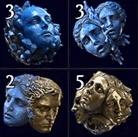
- Orb of Transmutation – upgrades a Normal item to a Magic item with 1 new Modifier.
- Orb of Augmentation – upgrades a Magic item with a new Random Modifier.
- Regal Orb – upgrades a Magic item to a Rare item.
- Exalted Orb – Augments a Rare item with a new Random modifier.
When upgrading to a new rarity, the current modifiers are retained, and a new one is added.
Unique or orange items cannot be upgraded from a lower rarity; they can only be found as a drop. But they can be modified by a special orb called the Vaal Orb.
Item Sockets
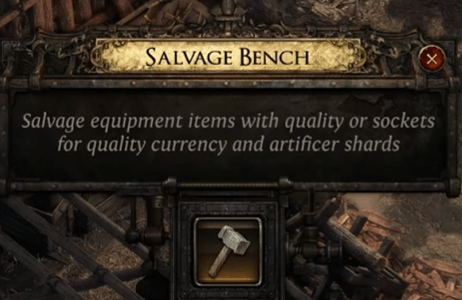
Some items you find will have sockets that can have Ezomyte runes placed in them, which adds more mods to the item. But what are you supposed to do to bad items with sockets that you don’t need? Well, you can salvage them to get parts of the Artificer’s Orb.
- Artificer’s Orb – adds a socket to a Martial Weapon or Armor.
Once you have it, you can then use it to add a socket to any armor piece or weapon you like! BLOG20
Unique Items
 Most of the items in the game are randomly generated, but not the Uniques. Each unique item, whether a piece of armor, a weapon, or anything else a character can equip, comes with a set of predefined, unusual mods that will change your entire build! Here are a few examples:
Most of the items in the game are randomly generated, but not the Uniques. Each unique item, whether a piece of armor, a weapon, or anything else a character can equip, comes with a set of predefined, unusual mods that will change your entire build! Here are a few examples:
- Corpsewade Iron Greaves (boots) – grant skill: Decompose.
- Decompose – any corpses you run through explode into clouds of poison.
- Sands of Sil Shrouded Vest (body armor) – grants skill: Blink.
- Blink – replaces dodge with a blink that turns you into sand that damages enemies.
- Quill Rain Shortbow (bow) – turns your bow attacks into full-auto mode by doubling the attack speed.
So far, 38 unique items are known about. There are definitely going to be more hidden ones that you would just have to discover with the rest of the community. If you’re looking for the best unique items in PoE 2, you can stop. While there may be some less popular unique items, 99% of them have their niche. It’s really a question of the right build rather than a good, unique item.
But how exactly do you get unique items? Acquiring unique items can be achieved through several methods:
- World Drops: Unique items can randomly drop from slain monsters and loot containers throughout the game world. The drop rates for these items vary, with more powerful uniques being rarer.
- Boss Drops: Certain unique items are tied to specific bosses, especially in the endgame. Defeating these bosses, particularly on higher difficulties or in their "Uber" versions, increases the chances of obtaining these exclusive uniques.
- Divination Cards: Collecting full sets of specific divination cards allows players to exchange them for designated unique items. These cards drop in particular areas or from certain enemies, providing a targeted farming method for desired uniques.
- Vendor Recipes: Some unique items can be obtained by trading specific combinations of items to vendors. These recipes are often discovered through experimentation or community sharing.
- Trading: Engaging with other players through the in-game trade system or external trade platforms enables the acquisition of unique items, assuming you have the necessary currency or items to exchange.
So, keep your eyes open for items that can change how your character works!
How to Get Gear?
So, we’ve talked about the equipment, ways to modify it, and about the item rarity. It’s all fine, but how to get gear in Path of Exile 2? If you’ve played literally any other ARPG before, you already know the answer. Let’s explore all the ways and methods that you can use to get gear.
Loot Drops
Loot drops are the most common way to obtain gear in Path of Exile 2. Every enemy, from basic monsters to powerful bosses, has a chance to drop equipment. Higher-level areas and stronger foes typically yield better loot. Certain encounters, such as unique boss fights, often have exclusive item drops that cannot be obtained elsewhere, which prove to be the best places for PoE 2 gear farming. Exploring the game world also reveals hidden chests and breakable containers, which can contain gear, currency, or crafting materials.
Tips for Maximizing Loot Drops:
- Equip items with increased item rarity or quantity modifiers.
- Focus on clearing high-density areas to maximize the number of enemies defeated.
- Take advantage of events like Breaches, Abysses, and Strongboxes for additional loot opportunities.
Crafting
Crafting in Path of Exile 2 allows players to customize and enhance their gear. Using crafting orbs and resources, you can modify the stats of an item to suit your build. Basic crafting involves tools like Orbs of Transmutation to upgrade normal items, Orbs of Alchemy to transform items into rare quality, and Chaos Orbs to reroll item properties. Advanced crafting methods such as Fossils, Essences, or Harvest mechanics enable targeted crafting for specific modifiers.
Crafting Essentials:
- Use crafting benches in your hideout (or in city hubs) for more controlled modifications.
- Save high-value crafting materials like Exalted Orbs or Annulment Orbs for endgame gear.
- Practice “blocking” undesirable mods using crafting bench prefixes or suffixes to narrow reroll outcomes.
Vendor Purchases
Vendors in towns and hideouts offer basic gear that refreshes as you progress through the acts. While vendor items are generally less potent than drops or crafted items, they can fill gaps in your gear, particularly in the early stages of the game. Additionally, vendors provide specific recipes where combining certain items results in a new piece of equipment. In PoE 2, vendors sell gear for gold. It’s been said that the developers want to make vendor gear more valuable, at least as you are working on completing the story acts.
Vendor Tips:
- Regularly check vendors in each act for resistance and health gear.
- Learn vendor recipes, such as three same-rarity items yielding a higher-rarity item or combining rings to make an amulet.
- Sell identified items for currency shards to fund purchases.
Trading
Trading with other players is one of the most efficient ways to obtain high-quality gear. The trade economy is based on in-game currency items, primarily Chaos Orbs and Exalted Orbs. Players can list their items on the trade site or use in-game chat channels to negotiate directly.
Uniques are also tradable. The only thing that you can’t exchange is gold.
Trading Tips:
- Familiarize yourself with currency values and fair prices for items.
- Use the official Path of Exile Trade website or community platforms to browse listed items.
- Avoid overpaying for upgrades in early levels; save your currency for endgame purchases.
Quest Rewards
Many quests in Path of Exile 2 reward players with gear options tailored to their character’s level and needs. These rewards are particularly helpful in early and mid-game stages, as they often include items with decent stats or utility modifiers.
Key Quest Rewards:
- Look for items that provide life, resistance, or damage increases.
- If unsure which reward to choose, prioritize gear with sockets compatible with your skill gems. BLOG20
- Some quests also reward currency or crafting materials, which can be used to improve other gear.
Divination Cards
Even though Divination Cards aren’t part of PoE 2. But, the chances are, they will be readded later on. So, divination cards are collectible items that, when turned in as a complete set, provide a specific piece of gear or crafting material. These cards drop from specific zones, enemies, or maps, making them a targeted farming method for specific items.
Using Divination Cards:
- Research drop locations for cards tied to the gear you want.
- Complete sets as you progress through the game or trade for missing cards.
- Store cards in the stash tab for future use, especially if farming endgame maps.
Endgame Activities
Once you reach the Atlas, endgame activities become the primary source of powerful Path of Exile 2 endgame gear. Mapping allows players to encounter a variety of challenges, including the story act bosses and unique bosses, each with exclusive loot. Delve into the mine for fossils and resonators, or explore other league mechanics present on the Atlas to increase the chances of getting rare gear.
Endgame Strategies:
- Upgrade maps to higher tiers for better loot drops.
- Farm specific bosses for their unique item drops.
- Use Sextants, Scarabs, and other modifiers to enhance map loot.
Conclusion
Gear in Path of Exile 2 plays a central role. For most ARPG gamers, gear is the main motivator for them to keep playing the game! Luckily, the way that PoE 2 handles the loot and equipment system makes it almost endlessly entertaining to chase down the most powerful items the game has to offer.
F.A.Q.
How does gear work in Path of Exile 2?
In short, the gear comes in 4 rarities, from Normal to Unique, with predefined properties and bonuses. The game allows you to upgrade the rarity of an item using Currency Items and add Rune sockets. There are many types of items, including armor, weapons, jewelry, flasks, etc.
What are the best uniques in Path of Exile 2?
All unique items offer something special, changing the way your character plays. Here are the most standout examples of Unique items:
- Atziri's Acuity Gloves – Provides a boost to damage and survivability.
- Daevata's Wind Spear – Adds skill-based projectiles for ranged gameplay while retaining melee utility.
- Lycosidae Shield – Offers blocking mechanics that enhance survivability without compromising offensive strategies.
Will Path of Exile 2 have set gear?
No, Path of Exile 2 does not have gear sets that provide additional bonuses for the more items from the set you have equipped.
What is the best gear farming spot in Path of Exile 2?
The best place to farm gear is by creating a specific map on the Atlas that has an increased chance for enemies to drop loot on their death. Add the modifier that increases the amount of enemies on the map for the best farming spot.

















